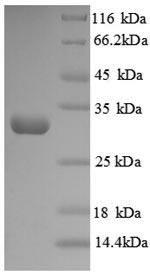Recombinant Human Protein-lysine 6-oxidase (LOX) is produced in E.coli and covers a partial protein region spanning amino acids 174 to 417. The protein features an N-terminal 6xHis-tag, which streamlines purification and detection processes. The product achieves a purity level that exceeds 90% when verified by SDS-PAGE, suggesting reliable performance across various research applications.
Protein-lysine 6-oxidase (LOX) appears to be a crucial enzyme within the human body. It plays what seems to be a critical role in crosslinking collagen and elastin fibers—components that are essential for maintaining structural integrity in connective tissues. Research focusing on tissue remodeling, fibrosis, and related cellular processes often considers LOX an important component.
Potential Applications
Note: The applications listed below are based on what we know about this protein's biological functions, published research, and experience from experts in the field. However, we haven't fully tested all of these applications ourselves yet. We'd recommend running some preliminary tests first to make sure they work for your specific research goals.
Human LOX is a complex enzyme that requires precise folding, copper cofactor incorporation, and lysyl tyrosylquinone (LTQ) formation for its functional activity in cross-linking collagen and elastin. The E. coli expression system cannot provide the necessary eukaryotic post-translational modifications and cofactor incorporation critical for LOX's catalytic activity. The partial fragment (174-417aa) represents only a portion of the full-length protein and may lack a complete structural context. While the protein may be soluble, it is highly unlikely to achieve the correct folding and cofactor binding needed for functional oxidase activity.
1. Antibody Development and Validation
Antibody development relies on antigenic sequence recognition rather than functional folding. This protein is suitable for producing antibodies against linear epitopes of the LOX fragment, but may not recognize conformational Epitopes.
2. His-Tag-Based ELISA Development
ELISA applications depend primarily on sequence-specific antibody recognition. This recombinant LOX protein is suitable as an immunoassay standard for detecting immunoreactive material against this LOX fragment.
3. Biochemical Characterization and Stability Studies
These studies are essential for determining protein quality. Analysis yields physical property data for this specific protein preparation, not the native LOX protein.
Final Recommendation & Action Plan
The E. coli expression system is fundamentally unsuitable for producing functional LOX enzyme due to its complex cofactor requirements. The immediate priority is Application 3 (Biochemical Characterization) to assess folding status through SEC and CD spectroscopy. Application 1 (Linear Epitope Antibodies) and Application 2 (ELISA Standard) can proceed regardless of folding status. For functional LOX studies, use full-length protein from mammalian expression systems that support proper cofactor incorporation.






